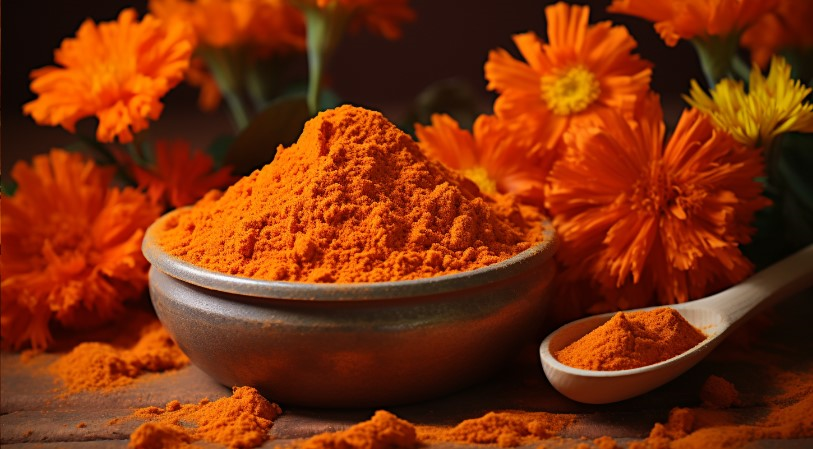What is zeaxanthin?

Zeaxanthin is an isomer of lutein. Both are carotenoids with the same chemical formula. The only difference lies in the different positions of the double bonds in the ring at one end.
The English name of zeaxanthin is Zeaxanthin, and some people also call it zeaxanthin. The carotenoids absorbed by the human body are mainly β-carotene. Lutein and zeaxanthin in the blood only account for about 20% and 3% respectively. However, up to 80% of the carotenoids in the macula of the retina are from leaves. Flavin and zeaxanthin.
Zeaxanthin is one of the most common carotenoids in nature. It is the color source of many plants such as paprika, corn, and saffron. Therefore, it is one of the phytochemicals, that is, plant nutrients.
Studies have shown that the ratio of lutein to zeaxanthin is 10:2, which can reduce the risk of age-related macular degeneration. However, similar to lutein, long-term and stable accumulation is required to achieve a protective effect on the macula of the eye.
In addition, you need to pay attention to the intake ratio of zeaxanthin and lutein. Because of the ratio problem, only an increase in zeaxanthin intake will not have the effect of eye health.
The importance of zeaxanthin to the human body
The macula is the area of the retina responsible for central vision, responsible for clear central vision and the ability to perceive color.
Zeaxanthin is mainly found in the center of the macular area of the retina, and lutein is mainly found around the macular area of the retina.
Lutein and zeaxanthin can filter blue light and ultraviolet rays, and they have strong antioxidant effects, thus helping to prevent damage to the macular area and retina from blue light, ultraviolet rays and free radicals. If sunglasses are the first line of defense against blue UV rays, lutein and zeaxanthin are the last line of defense, both important nutrients for protecting the macula.
How to supplement zeaxanthin?
There are no known side effects of taking too much zeaxanthin, but zeaxanthin is a type of carotenoid, and excessive intake may cause carotenemia, which can lead to yellowing of the skin.
Absorption & Metabolism Pathways in the Human Body
Zeaxanthin is a fat-soluble substance, that is, it is difficult to dissolve in water, so digestion, absorption and transportation in the blood must be coated by lipoproteins. It is necessary to use vitamin E, a fat-soluble vitamin, to effectively stabilize zeaxanthin and prevent it from being damaged and producing free radicals.
Zeaxanthin can be ingested from the gastrointestinal tract. After ingestion, the concentration in the blood can be significantly increased, but the concentration in the macula cannot respond quickly. Therefore, when zeaxanthin is ingested, long-term and stable accumulation is required before it can be present in the macula. Meaningful increase to achieve protective effect.
Sources of zeaxanthin intake
Zeaxanthin can be obtained from green leafy vegetables, such as spinach, cabbage, mustard greens, broccoli, and other yellow and green foods, such as pumpkin, peas, corn, yellow bell peppers, diced willows, egg yolks, etc.
Zeaxanthin intake
Studies have found that the ratio of lutein to zeaxanthin is 10:2, which can reduce the risk of age-related macular degeneration. Therefore, it is recommended that zeaxanthin supplementation should be used in conjunction with lutein.
The Reference Intake of Dietary Nutrients for Chinese Residents (2013) stipulates:
The specific recommended value of lutein for adults is 10 mg per day
The maximum tolerable intake is 40mg per day
Neither the U.S. Food and Drug Administration nor the European Food Safety Authority has set an upper intake limit for zeaxanthin.
References
[1] Karppi J, et al. Plasma lutein and zeaxanthin and the risk of age-related nuclear cataract among the elderly Finnish population. Br J Nutr, 2012, 108(1): 148-154.
[2] Moeller SM, et al. Associations between age-related nuclear cataract and lutein and zeaxanthin in the diet and serum in the Carotenoids in the Age-Related Eye Disease Study, an Ancillary Study of the Women’s Health Initiative. Arch Ophthalmol, 2008, 126(3): 354-364.
[3] Bone RA, et al. Macular pigment in donor eyes with and without AMD: a case-control study. Invest Ophthalmol Vis Sci, 2001, 42(1): 235-240.
[4] Seddon JM, et al. Dietary carotenoids, vitamins A, C, and E, and advanced age-related macular degeneration. Eye Disease Case-Control Study Group. JAMA, 1994, 272(18): 1413-1420.
[5] Li Chan, et al. Effects of lutein intervention on visual function in patients with early age-related macular degeneration. International Journal of Ophthalmology, 2017, 17(11): 2109-2111.
[6] Hu BJ, et al. Application of Lutein and Zeaxanthin in nonproliferative diabetic retinopathy. Int J Ophthalmol, 2011, 4(3): 303-306.
[7] Verywellhealth:The Health Benefits of Zeaxanthin
[8] Healthline:Lutein and Zeaxanthin: Benefits, Dosage and Food Sources
